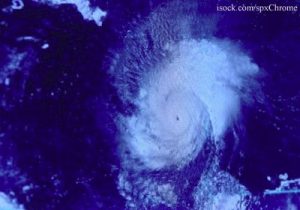If you live in an area that is affected by Hurricane Joaquin, the USDA has food safety tips for you. This hurricane has killed seven people in South Carolina and has caused extensive flooding.
 These types of weather events cause power outages that could compromise the safety of food. If you do lose power, keep appliance thermometers in the refrigerator and freezer to ensure that temperatures remain 40°F or lower in the fridge, and 0°F or lower in the freezer. Water frozen in one quart containers can keep food safe for a few hours. Dry ice or block ice is a good solution too.
These types of weather events cause power outages that could compromise the safety of food. If you do lose power, keep appliance thermometers in the refrigerator and freezer to ensure that temperatures remain 40°F or lower in the fridge, and 0°F or lower in the freezer. Water frozen in one quart containers can keep food safe for a few hours. Dry ice or block ice is a good solution too.
If the power goes out, keep the refrigerator and freezer doors closed as much as possible. A closed refrigerator will keep food safe for four hours, and a full freezer will hold a safe temperature for about 48 hours, or 24 hours if half-full. Use dry or block ice to keep the refrigerator as cold as possible. Fifty pounds of dry ice should keep a fully stocked 18-cubic-feet freezer cold for two days.
Once the immediate danger is over, check the temperature inside both appliances and discard perishable foods that have been above 40°F for more than two hours. Those foods include meat, poultry, seafood, eggs, and leftovers. Throw out any food with an unusual odor, color, or texture or feels warm to the touch.
Check frozen food for ice crystals. If the food still has ice crystals it can be safely refrozen. Remember to never taste food to see if it’s safe. Bacteria that cause food poisoning do not make food taste, smell, or look bad. When in doubt, throw it out.
Do not eat any food that has come into contact with flood water, including raw fruits and vegetables, cartons or milk, or eggs. Discard any food that wasn’t kept in a waterproof container if there is any chance it has touched flood water. Flood water is very dirty and can be filled with dangerous bacteria.
Food containers that are not waterproof include those packaged in plastic wrap or cardboard, and those with screw-caps, snap lids, pull tops, and crimped caps. Water can get into any of those containers. Also throw away cardboard juice, milk, or baby formula boxes and home canned foods if they have touched flood water because they cannot be sanitized.
Any canned foods should be inspected. If the cans are damaged, throw them away. Can damage can include swelling, leakage, punctures, holes, fractures, crushing, and denting.
You can see an extensive list of refrigerated perishable foods that should be discarded if they get too warm at the USDA web site. They include thawing meat, gravy, broth, cheeses, opened canned meats, cooked pasta or rice, fresh pasta, opened jars and bottles, fresh eggs, baked potatoes, precut greens, and commercial garlic in oil, among others.
The government has produced a YouTube video about food safety during power outages. They have also printed “A Consumer’s Guide to Food Safety” that you can download and print.




